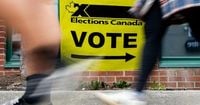As Canadians prepare to head to the polls on April 28, 2025, the final day of the federal election campaign has been marked by intense political maneuvering and a tragic event that has captured national attention. According to exclusive polling data from Nanos Research, the Liberal Party, led by Prime Minister Mark Carney, holds a narrow four-point lead over the Conservative Party, headed by Pierre Poilievre. The latest three-day rolling sample, conducted from April 24 to 26, shows the Liberals at 43 percent compared to the Conservatives at 39 percent nationally.
The New Democratic Party (NDP) trails significantly at eight percent, while the Bloc Quebecois stands at six percent, the Green Party of Canada at three percent, and the People’s Party of Canada at one percent. This polling data is crucial as Canadians prepare to make their voices heard in what is being described as a pivotal election.
Regional dynamics further illustrate the competitive landscape. The Liberals are maintaining strong support in the Atlantic region, Ontario, and Quebec, while the Conservatives dominate in the Prairies. British Columbia remains a battleground, with polls indicating a tight race between the two leading parties. Nik Nanos, the official pollster for CTV News and the Globe and Mail, stated, "B.C. remains an absolute toss-up between the Conservatives and the Liberals." In Ontario, the Liberals have seen their lead diminish from a double-digit advantage earlier in the week to just six points, with the latest figures showing the Liberals at 48 percent and Conservatives at 42 percent, while the NDP is at seven percent.
In Quebec, the situation is more favorable for the Liberals, who command 41 percent support compared to the Conservatives' 22 percent, with the Bloc Quebecois in second place at 26 percent. The Prairies, however, show a stark contrast, with the Conservatives leading significantly at 56 percent against the Liberals' 33 percent, and the NDP at nine percent. In British Columbia, both the Liberals and Conservatives are tied at 39 percent, while the NDP has dropped to 14 percent.
As the election approaches, the question of leadership preference also emerges. Mark Carney enjoys a 14-point advantage over Pierre Poilievre, with 49 percent of voters indicating they would prefer Carney as prime minister, while Poilievre garners 35 percent. NDP Leader Jagmeet Singh remains far behind at five percent. Notably, the gender breakdown reveals that women are more likely to support the Liberals, with 49 percent favoring them compared to 31 percent for the Conservatives. Conversely, men show a different trend, with 37 percent supporting the Liberals and 47 percent backing the Conservatives.
The dynamics among younger voters are particularly interesting. While the Conservative advantage among voters under 35 has narrowed, they still lead with 44 percent compared to the Liberals' 39 percent. The NDP's support in this age group has decreased from 13 percent to seven percent. Among middle-aged voters aged 35 to 54, the Conservatives hold a lead with 44 percent support versus 39 percent for the Liberals. However, older voters aged 55 and up show a strong preference for the Liberals, with 51 percent backing them compared to 35 percent for the Conservatives.
The methodology behind these findings comes from the CTV-Globe and Mail/Nanos Research tracking survey, which involved 1,291 respondents and has an accuracy of plus or minus 2.7 percentage points, 19 times out of 20. The survey's design ensures that the percentages are weighted to accurately represent the population by age, gender, and geography.
However, the political landscape was jolted on April 27, 2025, as a deadly car-ramming attack in Vancouver cast a shadow over the final campaign push. The attack occurred during a Filipino street festival, resulting in the tragic deaths of 11 individuals and injuring many others. Prime Minister Carney, visibly shaken, paused his campaign to address the nation, expressing heartfelt condolences: "Last night families lost a sister, a brother, a mother, a father, a son, or a daughter. Those families are living every family's nightmare." The suspect, a 30-year-old man with a history of mental health issues, was taken into custody.
In response to the attack, Poilievre condemned the act as a "senseless act of violence," expressing solidarity with the Filipino community. This incident has shifted the focus of the campaign, which had been dominated by discussions surrounding U.S. President Donald Trump's policies and their impact on Canada.
As the election nears, voters are increasingly aware of the stakes involved. Ottawa resident Brian Carr, 79, emphasized the importance of leadership in facing external challenges, stating, "This is an existential issue that we're facing," and expressing confidence in Carney's ability to navigate the complexities of international relations. Julie Dunbar, a 72-year-old Ottawa resident, echoed this sentiment, praising Carney's "experience on the international stage" as a crucial asset for Canada.
Meanwhile, Poilievre continues to focus on domestic issues, arguing that the Liberals' decade in power has led to rising living costs. At a rally in Oakville, he urged supporters, "Only one more day to bring home change so that Canadians can afford food and homes and live on safe streets." The Conservative leader's message resonates with voters who feel disillusioned by the current state of affairs.
As the final hours of the campaign unfold, the tight race between the Liberals and Conservatives raises questions about voter turnout and the potential impact of smaller parties like the NDP and the Bloc Quebecois. Historically, strong performances by these parties in key regions have influenced the overall seat count for the leading parties. However, recent polling suggests that both the NDP and Bloc may face challenges in this election.
With the polls set to open soon, Canadians are gearing up for a crucial moment in their democratic process, one that will shape the nation's future amidst a backdrop of both hope and tragedy.




